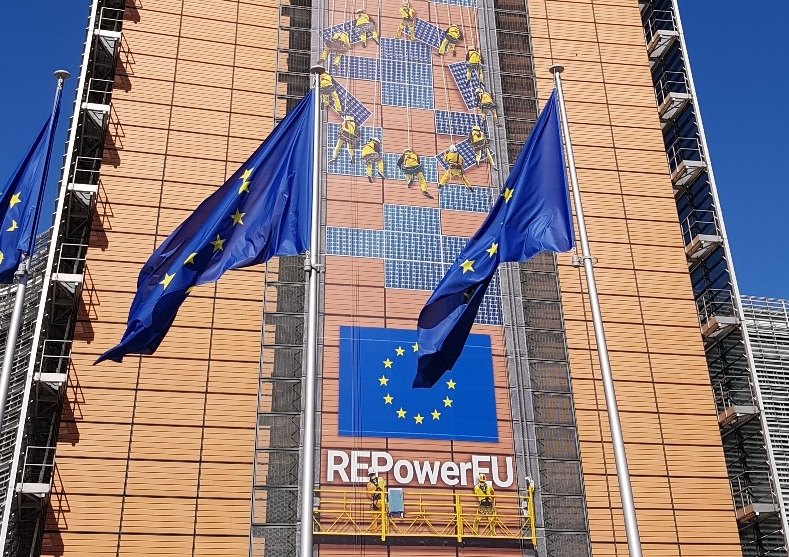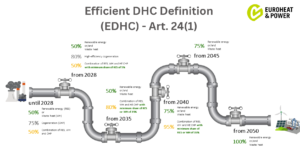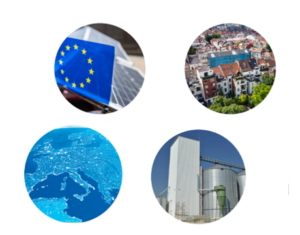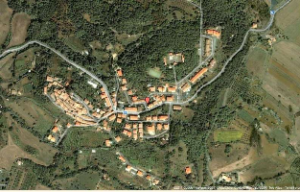EED & RED III – two amended directives to lead the way to climate neutrality
May 30, 2023
The European institutions have agreed on stricter binding targets for renewables and stricter rules for energy efficiency. The European Commission, the European Parliament and the EU Council ended the so-called trilogue and agreed on amended versions of the Energy Efficiency Directive (EED) and the Renewable Energy Directive (RED III). In order to become legally effective, however, the two directives still have to be finally confirmed by the EU Parliament and the EU Council and then published in the EU’s Official Journal.
Photo: Bärbel Epp
Afterwards, the EU member states have to transpose the regulations of the amended directives into their national legislations. Both directives are considered fundamental instruments for achieving the Green Deal goal of climate neutrality in the European Union by 2050.
RED III: Binding and indicative targets for renewables
According to the new version of RED III the compulsory target for renewable energies in total energy consumption is now to be 42.5 % by 2030, over 10 % more than in RED II, adopted in 2018. In addition, there is an indicative target of a further 2.5 %.
For the first time RED III defines a binding renewable target for the heating sector to ensure that renewable energies are not only used in the electricity sector. For the heating sector, previous indicative targets now become binding, with an annual increase of 0.8 percentage points until 2026 and 1.1 percentage points from 2026 to 2030. The agreed version of RED III also includes targets for different sectors of the economy:
- Renewable energies in district heating and cooling (art 24): +2.2 percentage points between 2021 and 2030 (indicative)
- Renewables in buildings (art 15a): 49 % (indicative)
- Renewables in industry (art 22a): 1.6 percentage points per year until 2030 (indicative).
A central element of the RED III is also to simplify and accelerate authorisation procedures for renewable energy projects. Member states are to designate expansion areas where projects can be tacitly approved if the approval authorities do not state any decision in a timely manner.
EED: Doubling the efforts of energy savings
The amended EED obliges all the EU member states to reduce their final energy consumption by 11.7 % compared to 2020 by 2030. This means they have to almost double their average annual targets of energy savings from the current 0.8 to 1.49 percentage points between 2023 and 2024. To achieve this, EU members have to adapt their National Energy and Climate Plans (NECP) accordingly.
In addition, the EED stipulates that at least 3% of public buildings, based on floor area, have to be energy efficiently renovated each year. For companies with an energy consumption of more than 10 terra joules (TJ) per year (2.8 GWh/year) energy audits will become mandatory. Larger energy consuming enterprises with more than 85 TJ annually (23.6 GWh/a) will be obliged to set up an energy management system.
No binding target for the expansion of renewable energies in district heating
Germany’s Economics and Climate Minister Robert Habeck welcomed the trilogue decisions as a “breakthrough”, expecting a “doubling of the expansion speed” for regenerative energies. Raphael Schenkel, European Affairs Officer of the German AGFW – The Energy Efficiency Association for Heating, Cooling and CHP made more reserved comments on the amendments. He acknowledges that renewable energies in district heating will be “generally strengthened” by RED III and the EED, but at the same time pointed out that there are “no binding quantity targets for the expansion of renewable energies in district heating” since there is only the indicative target that the share of RE and waste heat in district heating should be increased by 2.2 % annually by 2030.
One of the key articles for the solar thermal sector is article 24(1) with the definition of efficient district heating and cooling systems, which describes the way towards decarbonisation by 2050 by increasing the share of renewables and waste heat in several steps (see chart below).

EuroHeat & Power has illustrated the pathway towards carbon neutrality of district heating according to the definition for efficient district heating and cooling in article 24 (1) EED. The heat supply companies have several options to choose from to comply with the definition – either using a combination of renewables and waste heat (green), using highly-efficient cogeneration (grey) or by a combination of renewables, waste heat and highly-efficient cogeneration (yellow). Scheme: EuroHeat & Power
However, Schenkel pointed out that RED III does not contain any direct requirements for funding or funding opportunities for the district heating industry, as funding projects for district heating are mainly the responsibility of the EU member states.
EuroHeat & Power sees the revised directives as “good news for expanding and decarbonising district heating and cooling networks, which supply more than 60 million European consumers”. Managing Director Aurélie Beauvais also sees the need for additional support mechanisms. “We look forward to working with Member States to develop appropriate incentives and financing instruments, a prerequisite for ensuring ambitious implementation on a national and local level,” she is quoted in a press release from April 2023.
“In Germany, the state support programme BEW – short for federal funding for efficient heating networks, was launched for this purpose in September 2022“, Schenkel said, “it offers the possibility of supporting various renewable technologies and waste heat for decarbonising district heating networks, including solar thermal energy”. A similar support programme for district heating was also launched in the Czech Republic in mid-April 2023. Fuelled by the EU Modernisation Fund, a budget of EUR 1.2 billion is available until January 2026 for promoting green and more efficient district heating mainly based on renewable energy.
Organisations and initiatives mentioned in this article:
Energy Efficiency Directive (EED)
Renewable Energy Directive (RED III)
AGFW
EuroHeat & Power
National BEW programme in Germany
Green district heating in the Czech Republic


